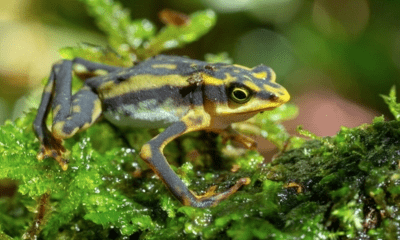Tree thought to be extinct rediscovered in Texas
Found in Big Bend National Park the tree considered to be one of, if not the rarest oaks in the world.
Published
2 years ago onBy
Talker NewsBy Danny Hapin via SWNS
A type of oak tree thought to have become extinct in 2011 has just been rediscovered in Texas, scientists have announced.

The tree is clinging on despite being scarred by fire and having a fungal infection and has immediately been put under conservation.
Scientists say climate change is making it more likely that drought and fire will kill it off and they are scrambling to find acorns with which to grow more.
Officially called Quercus tardifolia (Q tardifolia), the species was first described in the 1930s and the trees are about 30 feet tall.
Researchers led by The Morton Arboretum and United States Botanic Garden (USBG) say the oak is in poor condition and in immediate need of conservation.
They are also working with the National Park Service to protect it from wildfires and believe that studying the tree will help them protect other organisms from the same fate.
Dr. Susan Pell, executive director at the USBG, said: “The USBG is thrilled about the success of this partnership and collecting trip that rediscovered such a rare oak.
“The discovery is just the beginning of the conservation work we are doing in partnership with The Morton Arboretum to better understand and conserve threatened trees.”
Dr. Murphy Westwood, vice president of science and conservation at The Morton Arboretum, said: “This work is crucial to preserve the biodiversity that Earth is so quickly losing."
“If we ignore the decline of Q tardifolia and other rare, endangered trees, we could see countless domino effects with the loss of other living entities in the ecosystems supported by those trees.”
Dr. Westwood added that this tree, found on May 25 in Big Bend National Park, is considered to be one of, if not the rarest oaks in the world.
Carloyn Whiting, a botanist at the park, said: “This is important, collaborative research necessary for the conservation of Q tardifolia.
“The Chisos Mountains support a high diversity of oak species, partly because of the wide range of habitats available in this sky island. There is still much to learn about the oaks in the Chisos.”
While some scientists work on the immediate protection of the tree, others are working to classify it genetically to find out if it is in fact a different species than other oaks in the area.
This can be difficult as oaks tend to crossbreed or hybridize, which allows them to adapt faster to changing climate conditions like extreme heat or new diseases, but it also blurs the genetic lines between species.
Dr. Andrew Hipp of The Morton Arboretum, whose team is carrying out the genetic analysis, said: “This is an interesting problem.
“We’re looking into whether this tree is genetically similar to other trees that have been previously collected as Q tardifolia.
“That should tell us whether this collection of specimens is genetically distinct enough from other closely related oaks in the area to warrant recognition as a species.”
Dr. Hipp said it is important to preserve not just individual species but the whole genetic variation of life.
He added: “Species are genetically distinct populations that we can generally recognize in the field. But they aren’t the be-all and end-all of conservation.
“We also aim to protect the functional variation within species. Leaf forms, physiological responses to drought and fire and even tree longevity are all attributes that can be shared among populations and among species by gene flow.
“The functional variation that these new collections represent may be just what is needed to help oaks of the region adapt to environmental changes in the near or distant future.”
Oak acorns cannot be traditionally seed banked like other trees. They need to be preserved in the wild or in living collections, which is why the involvement of botanical gardens is so important to the project.
The researchers who found this oak are worried that it is not producing any acorns so they are trying other methods of reproducing the tree, such as grafting, which is done by taking a twig from the current tree and sticking it into the trunk of another.
Dr. Westwood said: “Across the planet, oaks serve as an ecological anchor cleaning the air, filtering water, sequestering carbon dioxide and supporting countless fungi, insects, birds and mammals.
“When one is lost, we don’t know what else we might permanently lose in its wake.”
She added that conservation efforts like this need collaborative initiatives, such as the Global Conservation Consortium for Oak, and the involvement of botanical gardens and a variety of scientific experts.
Dr. Wesley Knapp, the chief botanist at NatureServe, said: “In many ways, this tree is an ancient relic. Due to the changing climate, the world is completely different now than when it evolved.
“It is incumbent upon us to learn from it and protect it while we still can in order to inform future conservation efforts.
“Nature rarely hands us a second chance and I doubt we’ll get a third. We won’t waste it.”
Stories and infographics by ‘Talker Research’ are available to download & ready to use. Stories and videos by ‘Talker News’ are managed by SWNS. To license content for editorial or commercial use and to see the full scope of SWNS content, please email [email protected] or submit an inquiry via our contact form.
You may like


Frogs thought to be extinct found in Ecuador


How almonds can help people manage their weight


Study: American kids ditching alcohol for marijuana


Study: Short term memory can be improved using lasers


Lessons of the pandemic being used to help those hospitalized with flu


Study: Sexual predators use dating apps as hunting grounds
Other Stories


John Lennon’s lost ‘Help!’ guitar to break auction records
The iconic guitar is expected to fetch between $600,000 and $800,000.


Scientists clone two black-footed ferrets to save endangered species
The black-footed ferret is one of North America’s most endangered mammals.


Flight attendant reveals her top flight and travel tips
She has been a flight attendant for six years and traveled to 44 countries on thousands of flights.


How much is tipflation costing Americans every year?
Americans are spending much more on tipping than they want to.


Majority of American moms and dads feel lonely and burned out
And over 60% say they are burned out by their responsibilities as a parent.
Top Talkers

 Parenting6 days ago
Parenting6 days agoSingle mom details struggles of feeding her 12 kids

 Lifestyle5 days ago
Lifestyle5 days agoWoman regrets her tattoo nightmare: ‘It’s horrendous’

 Broadcast1 week ago
Broadcast1 week agoOver 40% of Americans have no clue what a 401k is

 Broadcast7 days ago
Broadcast7 days agoHow hard is it for Americans to live sustainably?

 Good News2 days ago
Good News2 days agoDisabled student takes first steps in 10 years on graduation stage

 Money1 week ago
Money1 week agoOver 40% of Americans have no clue what a 401k is

 Health2 days ago
Health2 days agoNew study reveals ‘old age’ begins later than it used to

 Environment7 days ago
Environment7 days agoHow hard is it for Americans to live sustainably?
